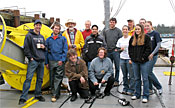You are here
Wecoma Research Cruise - April 2007
Date: April 03-06 2007
Ship: R/V Wecoma
Chief Scientist: Murray Levine
Documents: Microbiology Notes
Project Description
This short (4 day) research cruise accomplished several goals including recovery and deployment of a mooring, and establishment of a set of protocols for water sample collection and processing. We occupied a grid of stations over the Oregon continental shelf and slope to measure hydrographic (T, S, pressure), bio-optical (chlorophyll fluorescence, light transmission) chemical (nitrate, dissolved oxygen) and physical (ADCP subsurface velocity) parameters. We collected samples for DNA- and RNA-based microbial community analyses and water chemistry, and made continuous measurements of surface water chemistry with several devices attached to the seawater flow-through system.
[img_assist|nid=351|title=Wecoma at Dusk|desc=|link=popup|align=right|width=200|height=150]
The April cruise was a great success! The weather was perfect, and we stayed ahead of schedule for nearly the entire trip.
The cruise plan involved four transects consisting of over 40 casts, about 20 of which involved water sampling.
The whole team worked in three shifts, 8 hours off and 4 hours on, to operate the CTD and process the collected water samples.
[img_assist|nid=352|title=Wecoma wet lab|desc=|link=popup|align=left|width=200|height=150][img_assist|nid=355|title=CTD Cast|desc=|link=popup|align=left|width=200|height=150]
The first day required retrieval of an OrCOOS buoy and deployment of a mooring. Several team members then disembarked, and the rest of us prepared for our work shifts. Soon after, we discovered a stowaway octopus!
[img_assist|nid=353|title=Recovered OrCOOS buoy April 2007|desc=|link=popup|align=left|width=200|height=150]
[img_assist|nid=358|title=Mooring recovery and deployment|desc=|link=popup|align=left|width=220|height=170]
The team is thrilled about the number and quality of the samples obtained. For example, as expected, we observed obvious differences in the coloration of the Sterivex filters between surface and bottom water samples as well as differences between sites.
[img_assist|nid=356|title=GFF filters apparence after filtrating surface (dark) and bottom (light) seawater |desc=|link=popup|align=left|width=200|height=150][img_assist|nid=357|title=Sterivex filters apparence after filtrating surface and bottom seawater, CR4|desc=|link=popup|align=left|width=152|height=225]
We also managed to experiment with the a new data processing and telemetry pipeline. The network connectivity was surprisingly strong even at times over 20 miles offshore. The data collected from the Wecoma (ADCP, Flow-through CTD, and CTD casts) were parsed and processed in real time using a new CMOP Ocean Appliance, a hardware and software platform providing the same capabilities as the CMOP servers, but scaled down to a single desktop machine. When the network was in range, new and changed data were automatically pushed back to the servers.




